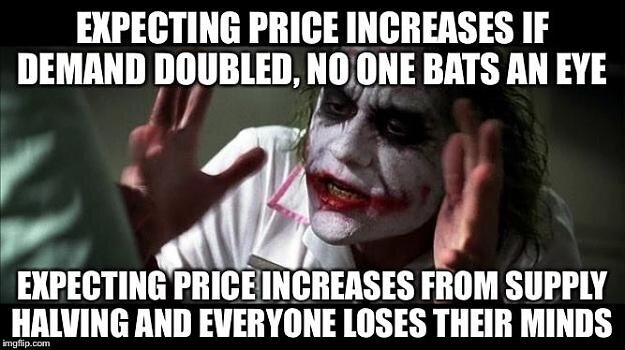Image credit: Andrey-Burmakin
This is my second Bitcoin halving event, but for many people following the crypto / bitcoin space this will be their first. I thought it might be useful to write a few words on the most common questions that I get asked about this significant event in Bitcoin.
The next halving takes place on May 12. What is the halving? Why does it happen every 4 years?
Bitcoin, by its design, is deterministically bound to follow a predefined supply curve. What this means is, the creation of new bitcoins (which is baked into the system and can’t be changed) is mathematically enforced to follow a known schedule.
It started off 11 years ago that every 10 minutes 50 bitcoins were emitted by the Bitcoin protocol (by the mining process). Roughly 4 years later, this dropped in half, so from the year 2012, only 25 bitcoins were created every 10 minutes. Then, 4 years later, in 2016, this halved again, so only 12.5 bitcoins were created every 10 minutes.
This event where the rate of emission of new supply cuts in half is a very important event in bitcoin known as the “Halving”. Nobody decides to do it. Nobody controls this. It is baked into the very DNA of bitcoin. Everyone who wants to participate in bitcoin has to agree that this is the way it is and it can’t be changed.
You can think about it like every 4 years half of the world’s gold mines suddenly vanished. This doesn’t change the existing supply, it just affects the rate at which new supply is created.
Why was Bitcoin designed this way and what does the bitcoin halving mean for demand?
The whole point of all this is for bitcoin to become harder and harder money over time. It is mathematically-enforced digital scarcity. That’s why people get so excited about it; it’s the opposite of what governments are doing with all this ‘quantitative easing’ / money printing — some are calling it ‘quantitative hardening’.
The bitcoin supply curve started steep (50 btc / 10 minutes) and gets flatter at every halving event. That’s how 87% of all bitcoin that will ever exist was created already in the first few years, while the last bitcoin that will ever exist won’t be created until after the year 2100 (if bitcoin still exists). It’s asymptotic. This doesn’t take into account all the bitcoins that are lost forever due to private keys being thrown away or forgotten; some estimates put this figure at 4 million btc (~20% of circulating supply).
image modified from https://www.bitcoinblockhalf.com/
So, the halving is directly linked to supply of bitcoin, and indirectly affects demand as people increasingly compete to acquire an asset that they know will become more scarce after the event.
Bitcoin is the first financial asset in history for which we have 100% predictable and deterministic supply many decades into the future.
Why and how does the halving affect the price of Bitcoin?
So, while halving doesn’t directly change demand for bitcoin, it does slash the new supply in half. Rudimentary economics theory would suggest that if you slash supply, with demand unchanged, then the price must rise. In reality there are many other things at work, with psychology, hype, and expectation playing a key role in price. Believers in efficient markets would suggest that since the supply change is known well in advance, then this should already be ‘priced in’ to the bitcoin price before the halving, and so price shouldn’t change. Others point out that when new supply drops, the bitcoin miners must keep more of the new coins to pay their operational expenses and so fewer coins make it to market, pushing the price up. Others still may be waiting to sell large positions on the back of all the hype, which could push the price down. So there are many factors at play here, and nobody knows for sure. It could just be a big non-event.
Past performance is not a guarantee of future returns. That said, the halving has previously happened two times in bitcoin’s history (this next one will be the third time). So of course there is much speculation about what is going to happen. The last two times it happened, this preceded a bull run over the following months where price rose many thousands of %. But that doesn’t guarantee this will happen again. Especially since 4 years ago there are now more sophisticated ways of betting against the price (like futures or other derivative instruments) whereas last time there was only buy or not buy, so downward price pressure was suppressed.
Is it time to invest? Is it better to invest before or after the halving ?
We should expect some volatility. The bitcoin investor community is much larger than it was 4 years ago and many are encountering the halving for the first time. Google trends confirms that searches for ‘bitcoin halving’ has broken out to an all time high in recent weeks.
Many people will get swept up in the narrative of the halving and invest lump sums over the coming days expecting a quick return. Cautious investors will likely not try to trade this event given the uncertainty. Long-term investors may choose to reduce the effect of volatility by ‘dollar cost averaging’, i.e. buying smaller amounts regularly over a longer time period, in order to smooth out the price fluctuations and reach an average price. Time-preference and risk appetite should also play a role.
The Bottom Line is that it’s impossible to give advice that is guaranteed to be good advice. I would just advise people to manage their risks accordingly.
Andy
May 2020



